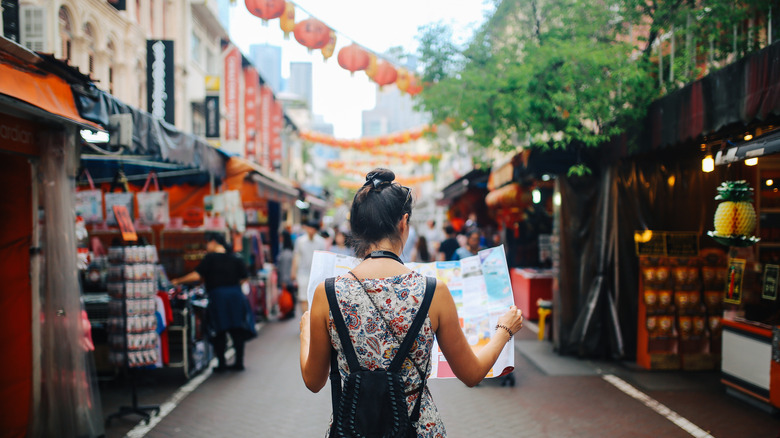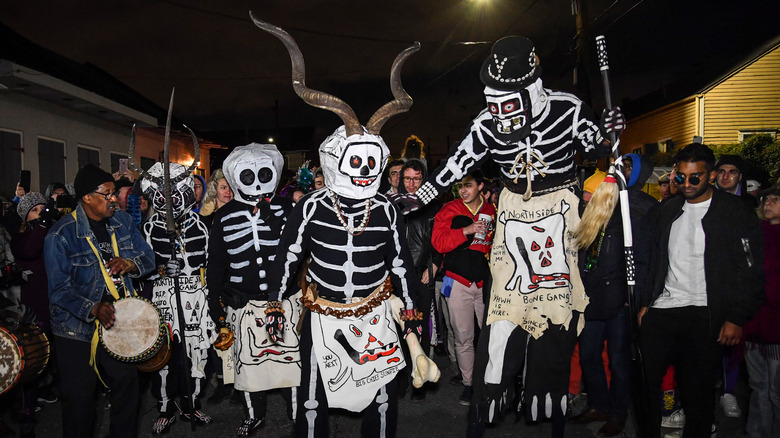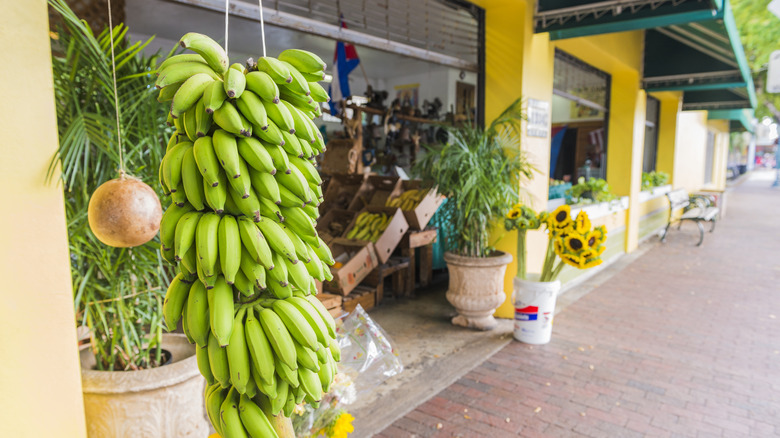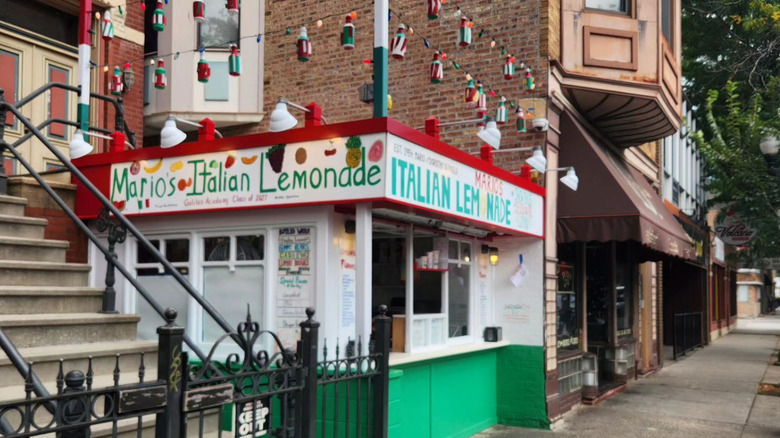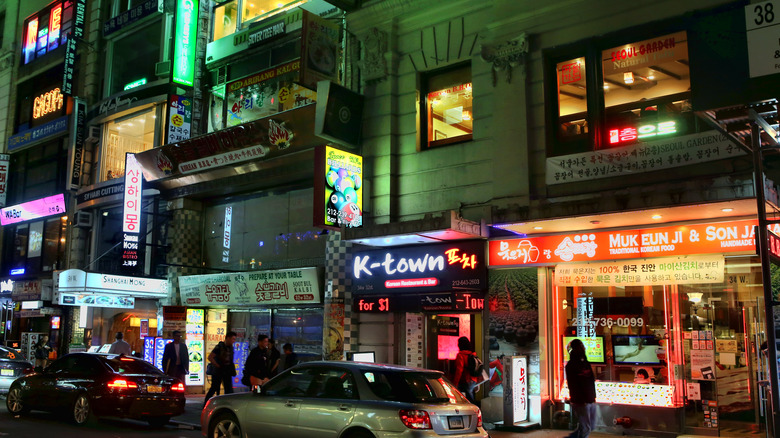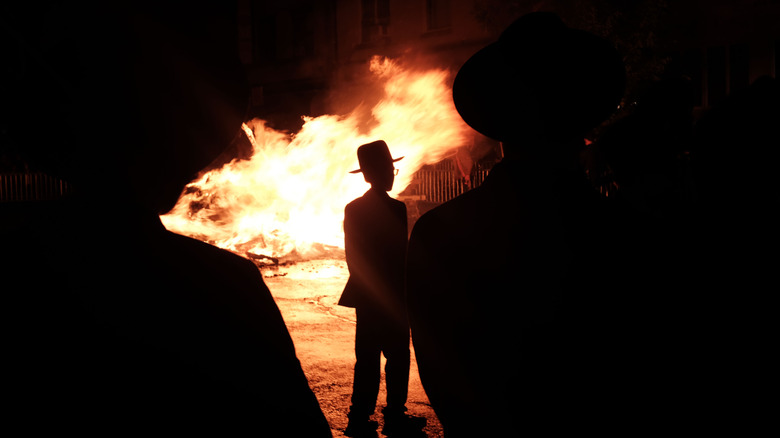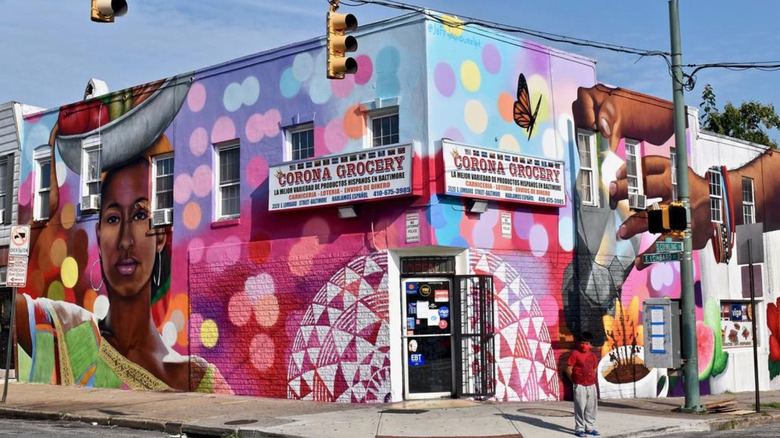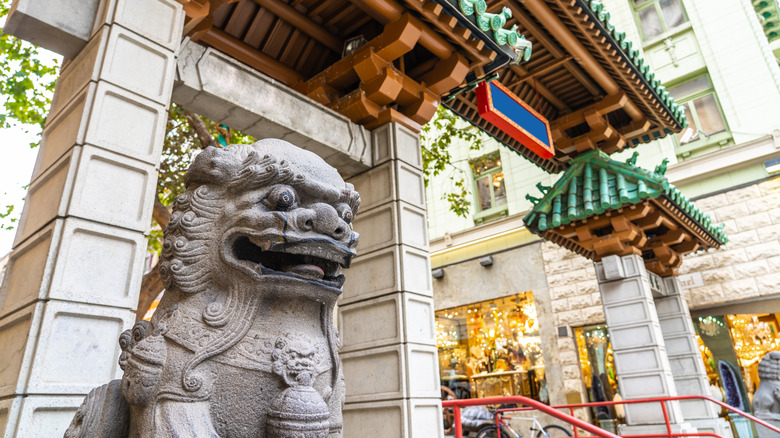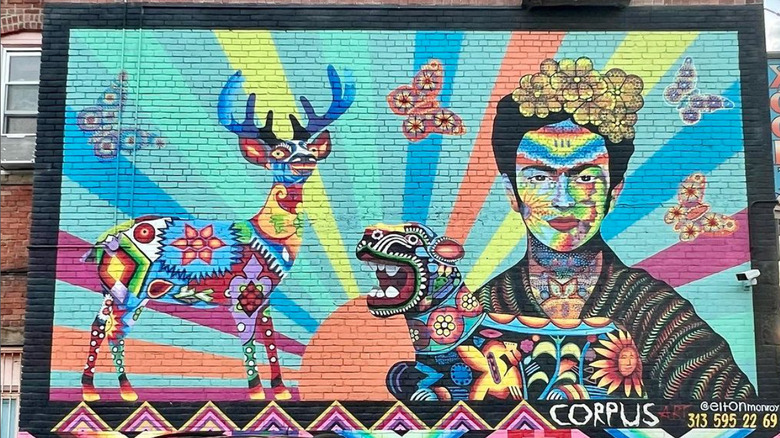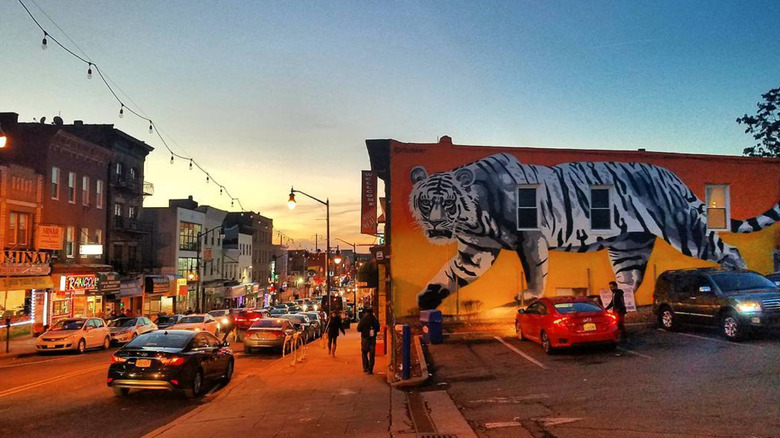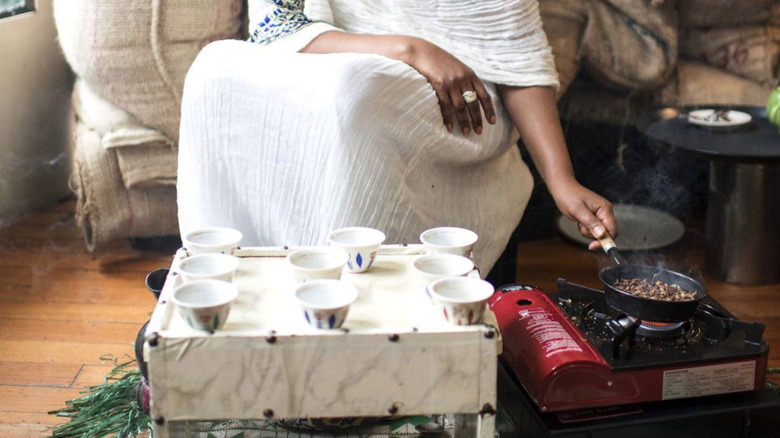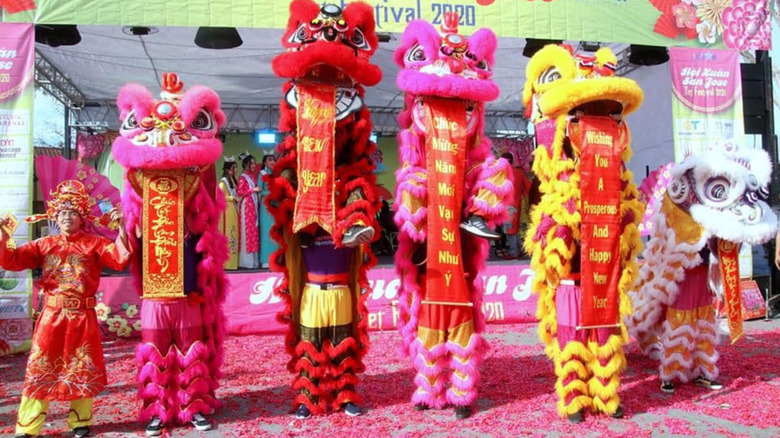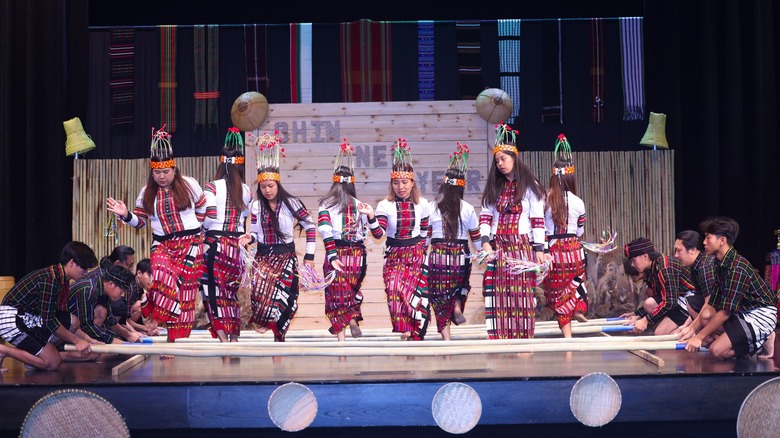Must-Visit Ethnic Neighborhoods For Culture Seekers In The US
Your tickets are booked, your bags are packed, and you're ready to set off on an adventure exploring a brand-new city. Of course, there are a whole slew of attractions and must-dos to cover, no matter what city you're bound for. While seeing the Statue of Liberty or taking a tour of D.C.'s Capitol Hill are certainly things to check off your U.S. travel bucket list, inserting a bit of culture into your trip should also be a priority. Not only will some exposure to the local heritage result in a more profound journey, but you haven't truly visited a city until you've gotten to know the locals who have made it into what it is.
The United States is famously diverse, the result of centuries of migration from all corners of the world. While most cities remain a melting pot, ethnic micro-neighborhoods that naturally emerged as people started new lives in America are points of flourishing culture. Visiting some of these enclaves provides direct insight into how heritage and traditions remain intact in America and are one of the genuinely breathtaking aspects of the country.
Tremé in New Orleans, Louisiana
Thanks to the many groups that have influenced the traditions and superstitions of this unique city, New Orleans is a culture bomb. Creole, French, and Haitian heritage can be seen throughout the city, but Tremé remains a concentrated community of Black and Creole residents with strong traditions. Established in the 1810s, the historic neighborhood is considered the oldest Black neighborhood in America and played a big part in making NOLA the culture-rich community it is today.
If you visit New Orleans during Mardi Gras, you'll likely see Tremé represented in the festivities. Actually, the very first celebration of the holiday's main day takes place in the neighborhood, with skeletons emerging before the sun and skulking the streets. The Skull and Bone Gang wakes up the neighborhood in a tradition over a century old.
While it may be tough to catch this part of Tremé's culture if you're not an early riser, there are museums and places of tradition all over the neighborhood showcasing its spirit. The Backstreet Cultural Museum and the New Orleans African American Museum are both located here, as well as Congo Square, where heritage and music festivals find a home.
Little Havana in Miami, Florida
If you have dreams of visiting Cuba but can't make the trip work, Miami is the next best thing. Little Havana is just 25 minutes from South Beach, and while you can't soak in the sun celebrity style, you'll feel as though you are on a completely different vacation when exploring the markets and art-laden streets.
If you visit Miami without trying some Grade-A Cuban food, have you even been to Miami? The city's best Cuban food is naturally found in Little Havana, and foodies won't want to miss out on the open-air food markets. El Palacio De Los Jugos is the perfect market for those who don't quite know what they're in the mood for, as everything from fresh pressed juices and hand-cut coconuts to made-from-scratch baked goods and whole-roasted pigs is available. You can hand-pick a feast fit for kings here.
Calle Ocho is one of Miami's most vibrant and Cuba-centric streets, and taking a stroll here is a great way to experience Little Havana. Spending a day or two in the neighborhood is like a vacation within a vacation, with Miami Beach and the rest of the city having a completely different feel compared to the laid-back vibe of the Cuban enclave.
Little Italy in Chicago, Illinois
It's hard to imagine what Chicago would be without the influence of the Italians who have made the city their home. Little Italy is a must-visit for fans of Italian food, and strolling through the neighborhood should include dropping into a cafe or bakery while also admiring the impressive churches that can be found here.
Scafuri Bakery has been serving up classic Italian baked goods for over a hundred years, and stopping in for a pastry before exploring the rest of Little Italy is an expert move. Just five minutes up the street is another century-old sugar slinger, Ferrara Bakery. Their confections are also a community staple, with the addition of a sandwich shop serving up meatball subs and pasta dishes. Don't forget to grab an espresso — Cafe L'Appetito is nearby and a good caffeine checkpoint. If coffee isn't your drink, Mario's Italian Lemonade is an oldie but goodie for those with sweeter tastes.
The Shrine of Our Lady of Pompeii and Notre Dame de Chicago Church are two of the most iconic Catholic churches in the neighborhood. They're impressive inside and out, and admiring beautiful churches is as invigorating in Little Italy as it is in the motherland across the ocean.
Koreatown in New York City, New York
New York City is essentially a mass of micro-neighborhoods, and exploring each thoroughly could take a lifetime. Koreatown is one such community that isn't talked about as much as some of the Big Apple's most iconic areas — like Harlem and Little Italy — but shouldn't be discounted. Like most ethnic neighborhoods, K-Town is a mecca for the food of the people who call it home, and you should undoubtedly pack your appetite before heading here.
If you enjoy Korean food, plan on visiting Koreatown around lunchtime every single day of your NYC trip. Popular eateries and hole-in-the-walls line the streets of Korea Way, making it possible to eat at a different restaurant for every meal for quite some time without becoming a repeat customer. The selection can be overwhelming, but you'll find authentic fare everywhere, from bibimbap to bulgogi and beyond.
Mouthwatering food aside, Koreatown surrounds some of the most prominent attractions of NYC, like the Empire State Building and Madison Square Garden, but the neighborhood is home to some pretty great hidden gems as well. Koryo Books is an original Ktown staple and a necessary pitstop for bibliophiles, while Maru Karaoke Lounge lights up the night for even the most off-key patrons.
Borough Park in New York City, New York
There are few places in the world with as sizeable a Jewish population as New York City, and various neighborhoods have a high percentage of Jewish residents. Borough Park is one such spot and is home to a large population of Orthodox and Hasidic Jews, two traditional subsects of the religion. As such, you will find several kosher markets and eateries here, as well as a few synagogues — like Temple Beth El — and residents in traditional Hasidic Jewish clothing.
Borough Park holds an annual Lag B'Omer celebration, which centers around a massive bonfire to commemorate the 33rd day of the Counting of the Omer, as thousands of people come to the neighborhood to dance and listen to live music during this traditional Jewish holiday. While there are plenty of Jewish neighborhoods in Brooklyn, exploring Borough Park will bring a unique experience to visitors that is a bit closer to the traditional customs of the ancient religion.
Highlandtown in Baltimore, Maryland
Though Baltimore is primarily a Black city with Black culture dominating throughout, Highlandtown is home to a large concentration of Hispanic people whose culture is proudly displayed throughout the neighborhood. Located next to Patterson Park, the tight-knit community regularly gathers for festivals and events that showcase their creativity and flourishing personalities. First Fridays are a big deal here, with live music and the arts taking over the neighborhood monthly. Even when the art galleries and creators aren't out in full force during these regular events, Highlandtown is teeming with color, as street art adorns most blocks and even the roads. Gorgeous murals are everywhere, from walls to streets, trash cans, and any other surface an artist might deem a canvas. Most of these art pieces celebrate cultural heritage or are dedicated to positivity and community.
Food is also kind of a big deal in Highlandtown. The cantinas and eateries in Highlandtown are some of the most popular in Baltimore, with Sally O's and Snake Hill two fabulous options for peckish visitors. You'll not only find Latin-inspired dishes here, but foods from other cultures as well.
Chinatown in San Francisco, California
There are many Chinatowns throughout the world, but the most iconic (and largest) of these vibrant communities is found on the West Coast in San Francisco, where around 70,000 people live in 30 blocks packed with culture, heritage, history, and cuisine. It is a must-see when traveling around San Francisco.
This neighborhood is an important enclave in preserving Chinese culture in San Francisco. The Dragon Gate marking the southern entrance of the neighborhood was given to the city by the Republic of Taiwan. While a trip here may not be quite as authentic as stepping foot in China itself, it's pretty darn close.
You could spend days immersing yourself in the many shops throughout Chinatown, but starting at Canton Bazaar will give you a leg up on understanding what the neighborhood has to offer — it's a minimalist's dream come true. When it comes to food in Chinatown, avoid anywhere that's handing off coupons out front and try to seek out where the locals are eating.
Mexicantown in Detroit, Michigan
Detroit has its own sense of culture and is big on community, which is especially true when it comes to Mexicantown. There is no better place in Motor City to celebrate Latino traditions while experiencing authentic Mexican food and a culture of creativity.
Detroit is a wildly creative city and has a reputation as an up-and-coming art-inspired destination, and Mexicantown has its fair share of contributions to this cause. Bold and colorful murals paint the neighborhood paying homage to Mexican icons, landscapes, and styles. Old murals are mixed in with more modern ones, with street artists coming together to make Mexicantown a lasting part of creative Detroit.
A fun way to experience the culture of Mexicantown is to visit during Día de los Muertos. The neighborhood puts on its own special celebration for the holiday, with businesses displaying art in their windows and residents coming out to march and dress in elaborate costumes.
Little India in Jersey City, New Jersey
If you love Indian food, a trip to Jersey City will have you like a kid in a curry-flavored candy store, as Little India is so flush with fantastic food you won't know what to taste first. From sweets to savory dishes, the micro-neighborhood has many eateries touching on the incredible cultural diversity of Indian cuisine. India Square greets you with a massive white tiger mural, with shops and restaurants clustered close together. Swadist is a popular eatery that marries Indian food with Chinese and Thai dishes. Good luck deciding between butter chicken and Penang curry!
Not hungry? If you are looking for Indian fashion, Sunanda Kumar has a wide selection of jewelry and saris. There are also many Indian festivals taking place regularly in the neighborhood, and visiting during one of them — like Navratri or Holi — can be wildly rewarding and educational, not to mention heaps of fun.
Little Ethiopia in Washington D.C.
Washington D.C.'s museums and politics tend to overshadow anything else in the country's capital, but a quick exploration of Little Ethiopia will completely transform the typical D.C. experience. The capital is home to the largest Ethiopian population in the United States, and they have instilled their culture into the bones of the city with flourishing businesses and a strong community.
Eateries are packed into Little Ethiopia, and they're all fantastic. You could close your eyes, point, and spin to decide on a place to satisfy your hunger and pretty much be promised a delicious meal. If such spontaneity makes you shudder, head to Keren Cafe & Restaurant for good Ethiopian fare from early in the morning until late at night.
While the Ethiopian food here is magnificent, it's not the only thing your tastebuds need to experience. You have to try the coffee, and there are plenty of places to have an authentic Ethiopian coffee experience, whether it's just a cup or a full-blown caffeinated ceremony. Rue Café offers a wide selection of brews that range in flavor profiles from floral to smoky, while Sidamo Coffee roasts its own coffee beans in-house and sporadically provides a traditional ceremony, also called jebena buna.
Little Saigon in San Jose, California
The Vietnamese community in San Jose has created something truly wonderful in Little Saigon, and the neighborhood is packed with good food and education. The Californian city is home to over 130,000 Vietnamese people, and they have imbued their culture into their ethnic enclave beautifully.
The food here is phenomenal. If you are a lover of Vietnamese food — pho, bánh mì, and everything in between — then heading to Little Saigon is a no-brainer. There are plenty of other attractions in the neighborhood that do not involve food, though. Tết, the Vietnamese lunar new year, is a great time to visit because the streets are full of thrilling costumes as celebrators revel in the annual festivities. If you aren't able to visit during the festival, you should stop by the Viet Museum. Located in a historic home, the museum tells of the history of Vietnamese people and their journey to the United States.
Chindianapolis in Indianapolis, Indiana
Indiana is home to a significant Burmese population, most of whom reside in Indianapolis. Since relocating to the city as refugees, around 20,000 Chin people have settled in Southport, forming the micro-neighborhood of Chindianapolis, where the culture is fresh and the food is delicious.
Chindianapolis is one of the newer ethnic neighborhoods in America, especially when compared to older neighborhoods like San Francisco's Chinatown and Chicago's Little Italy. As such, you won't find any restaurants or markets that have been around for nearly a century. Instead, you'll be surrounded by more modern endeavors of people who have practically restarted their lives. The Chin Brothers Restaurant and Grocery is one such business that has emerged in the flourishing neighborhood. There are not many places in the country where you can experience Chin food, even at a Burmese restaurant, so the opportunity to taste an authentic Chin dish shouldn't be passed up.
Chin traditions are starting to take root and bloom in Indianapolis too, as the first Chin New Year Festival took place here in 2023. The festival honors the new harvest and features dancers and speakers in gorgeous traditional attire with complex patterns and beading. It's a beautiful display of community and heritage that culture seekers shouldn't miss.
